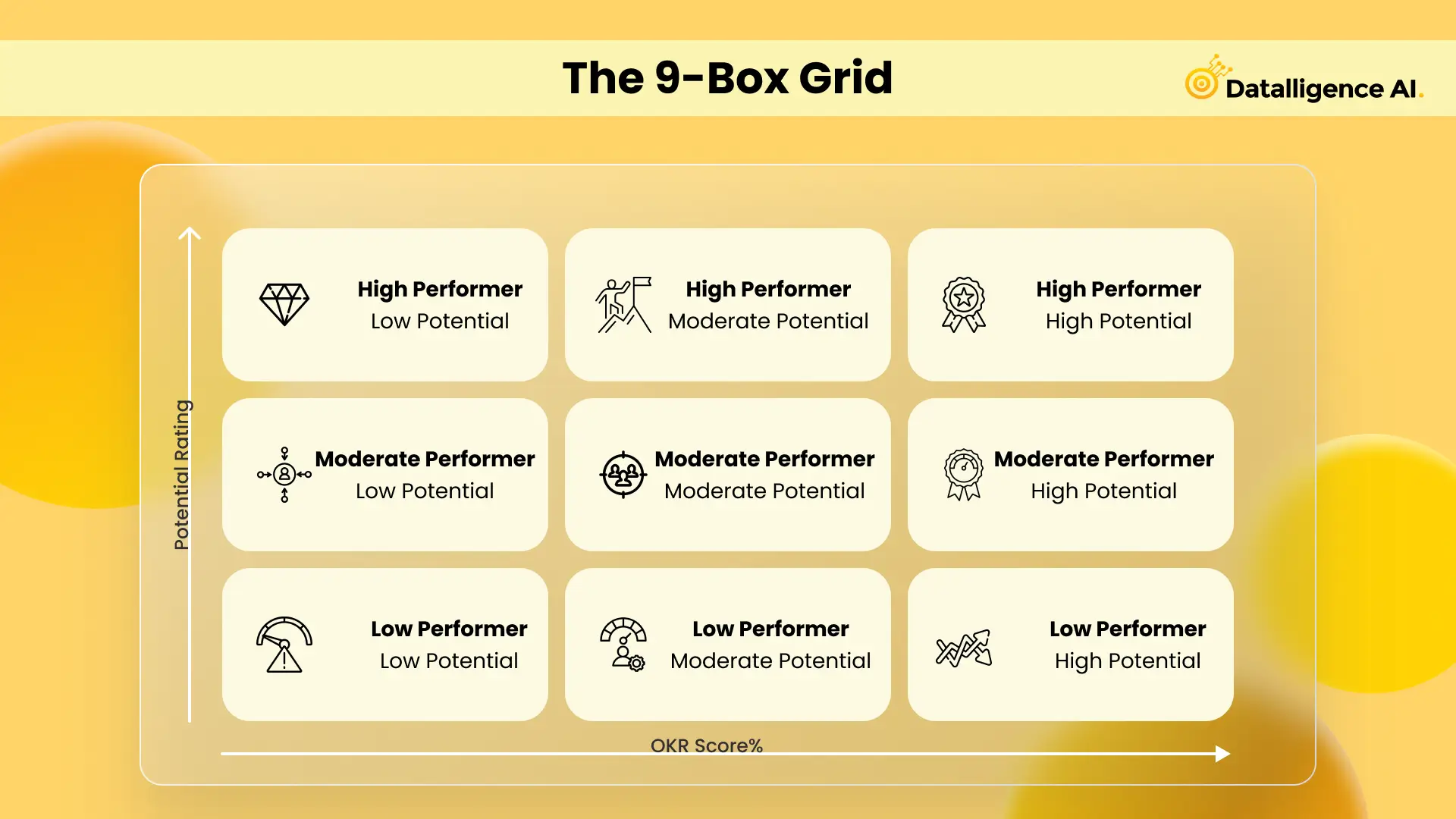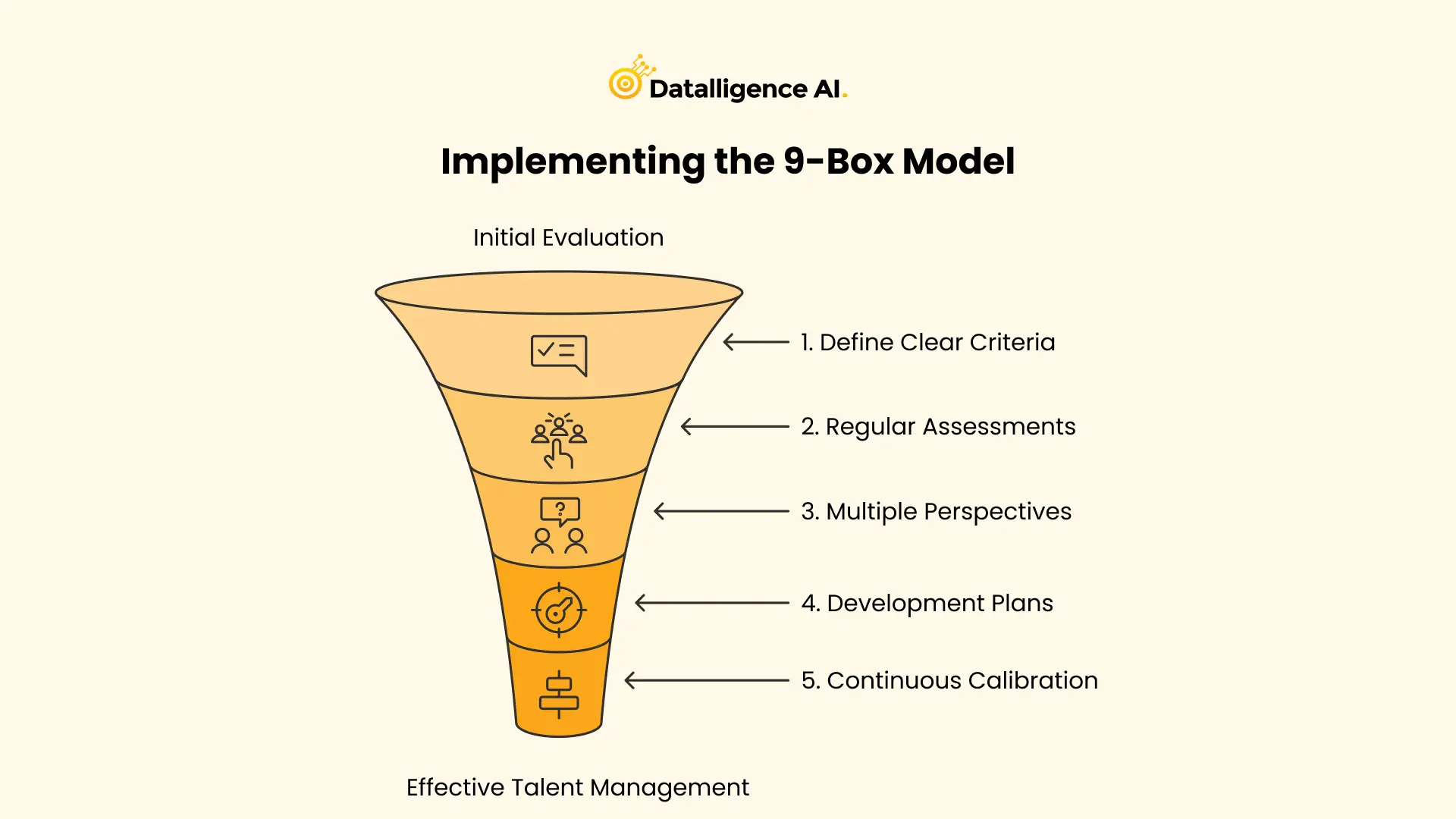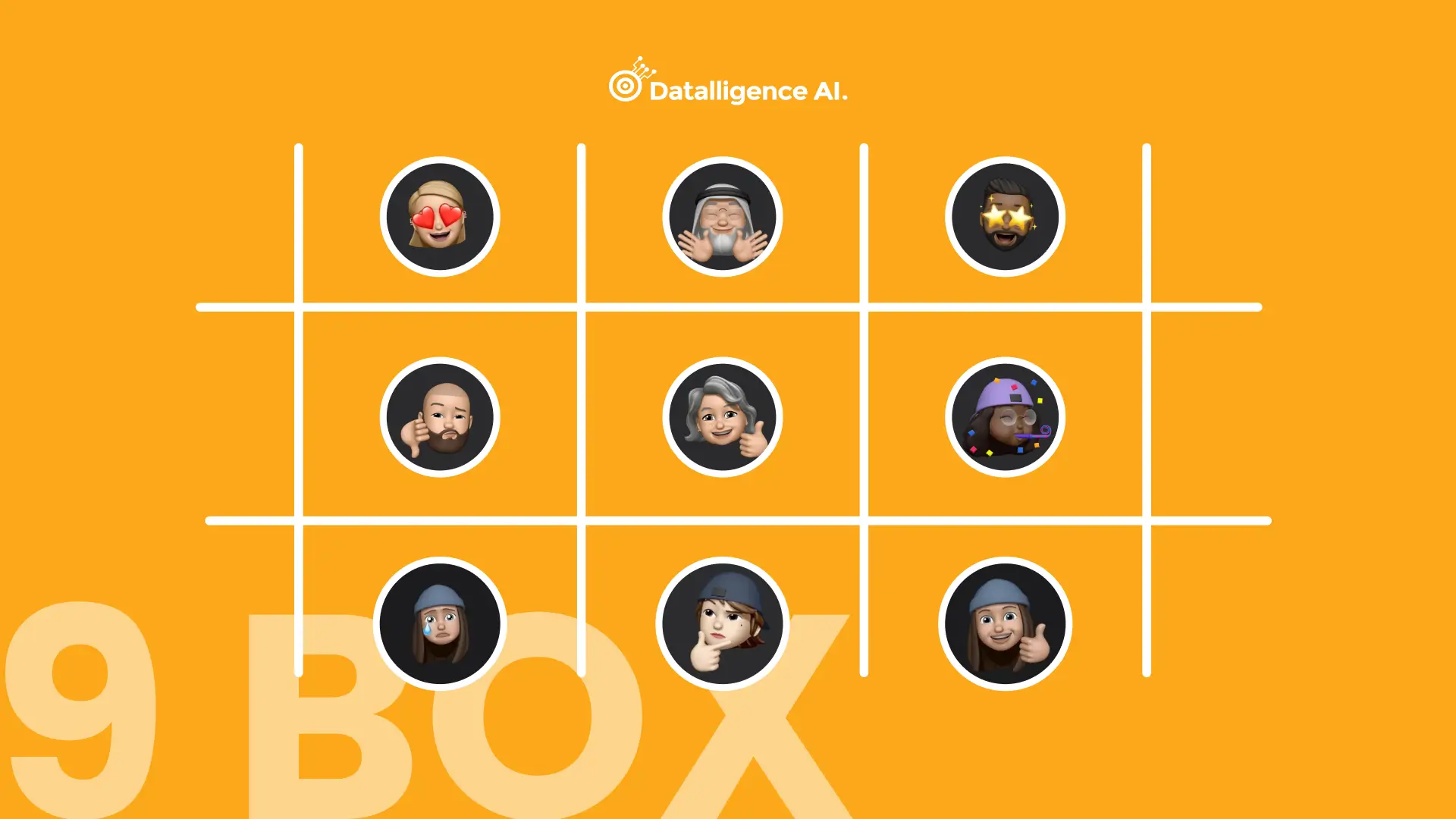Imagine you’re a manager with a team full of diverse talent, each employee performing at different levels and showing varying potential for growth. The challenge is knowing how to recognize these differences, develop your team, and plan for the future effectively. That’s where the 9-box model comes in, offering a straightforward yet powerful way to assess and develop employees based on both their current performance and their potential for future growth.
Lets explore how the 9-box model can help your organization identify and nurture high performers, spot emerging talent, and implement effective succession planning strategies.
Table of Contents
What is the 9-Box Model?
The 9-box model is a talent management tool that helps organizations evaluate employees based on two critical factors: current performance and future potential. It’s presented as a 3×3 grid, which divides the two factors into three levels: low, medium, and high. These levels create nine distinct boxes, each representing a unique combination of performance and potential. This framework allows organizations to visualize their talent pool and make data-driven decisions about development, promotions, and succession planning.
This model originated in the 1970s at General Electric through a partnership with McKinsey & Company. It quickly became a staple in talent management across industries for its simplicity and effectiveness in evaluating human capital.
The 9-Box Grid: Breaking Down the Boxes
At the core of the 9-box model, each box represents a combination of two important dimensions: Performance (horizontal axis) and Potential (vertical axis). Let’s dive into what each box represents:

Box 1: Low Performance, Low Potential
These are employees who are both underperforming and unlikely to develop significantly. They may require immediate attention—be it through performance improvement plans or considering a transition out of the company.
Box 2: Medium Performance, Low Potential
Employees in this box perform adequately but have limited growth potential. They are solid contributors but may not be able to take on more significant responsibilities. It’s crucial to recognize and retain them but set realistic career expectations.
Box 3: High Performance, Low Potential
These employees excel in their current roles but show limited potential for upward mobility. They can be excellent at what they do, and it’s important to recognize and retain them for their expertise, but they may not be ideal candidates for leadership positions.
Box 4: Low Performance, Medium Potential
Here, employees may show promise for growth but are currently underperforming. These individuals could benefit from additional training, support, or perhaps a role change to unlock their potential. It’s essential to provide targeted interventions to improve their performance.
Box 5: Medium Performance, Medium Potential
These employees are reliable, performing at an average level with moderate potential for growth. They’re your “core players,” essential to the day-to-day operations of the organization. It’s important to provide opportunities for further development to help them progress.
Box 6: High Performance, Medium Potential
Employees in this box exceed performance expectations, but they may have reached their ceiling in terms of potential for advancement. They could be highly valuable in specialized roles or technical positions but might not be suitable for senior leadership tracks.
Box 7: Low Performance, High Potential
This group shows significant promise for future leadership or advancement but is currently underperforming. They could benefit from a role change, additional coaching, or mentorship to help them reach their full potential.
Box 8: Medium Performance, High Potential
These are your “rising stars” – individuals who perform well and demonstrate strong growth potential. They should be developed with targeted programs, leadership training, and challenging assignments to prepare them for future leadership roles.
Box 9: High Performance, High Potential
These are your top performers – exceptional in their current roles with the potential to rise through the ranks. They should be prioritized for leadership development and succession planning. Investing in their growth ensures that your organization is prepared for the future.
Why the 9-Box Model Works
1. Strategic Talent Management
The 9-box model provides a structured, visual approach to understanding your organization’s talent pool. It helps you allocate resources effectively, invest in the right development programs, and focus on areas that need attention.
2. Succession Planning
By identifying high-potential employees, you can build a strong succession pipeline for key roles. This helps ensure continuity in leadership positions and critical functions, preparing your organization for future challenges.
3. Performance Differentiation
The model helps distinguish between employees based on their performance and potential. This differentiation allows for more personalized development plans and avoids a one-size-fits-all approach to talent management.
4. Better Resource Allocation
With clear data on where employees fall within the grid, you can allocate training, coaching, and mentorship resources where they’re most needed. For example, high-potential but underperforming employees (Box 7) may need coaching, while high performers with limited potential (Box 3) may benefit from new challenges in their current roles.
5. Career Development
The model facilitates meaningful discussions between managers and employees about their career development. It can help employees understand where they stand and what steps they need to take to move to the next level.
How to Implement the 9-Box Model

1. Define Clear Criteria
To make the 9-box model effective, start by defining clear, objective criteria for both performance and potential. Performance should be based on measurable outcomes like meeting targets or achieving KPIs, while potential could include factors like leadership skills, adaptability, and ability to learn.
2. Regular Assessments
Make the 9-box assessment a regular part of your performance reviews. Conducting these assessments annually or biannually ensures that the evaluations remain up to date and reflect changes in employee performance and potential.
3. Multiple Perspectives
Gather feedback from multiple sources to ensure a well-rounded view of each employee’s performance and potential. This might include input from direct managers, senior leaders, peers, and even self-assessments to get a holistic view.
4. Development Plans
Once you’ve placed employees in the grid, create personalized development plans for them. These plans should be designed to help employees move towards higher potential and performance levels, with concrete steps like training programs or new responsibilities.
5. Continuous Calibration
The 9-box model should evolve as employees develop and as your business needs change. It’s essential to regularly review and adjust employee placements, especially for those who are showing significant growth or have faced new challenges.
Overcoming Common Challenges
Subjectivity in Assessment
Challenge: Managers may assess potential too subjectively or inconsistently.
Solution: Provide training on how to assess potential objectively, with specific criteria to guide evaluations.
Over-Focus on High Potentials
Challenge: The focus on high-potential employees may leave out core performers who are still valuable.
Solution: Recognize the importance of steady, high-performing employees in your organization’s success, and provide them with growth opportunities that align with their strengths.
Employee Concerns
Challenge: Employees may feel boxed in or discouraged by their placement on the grid.
Solution: Use the 9-box model as a tool for development, not labeling. Emphasize that everyone has room for growth and that their current placement is just a starting point for future development.
Cultural Fit
Challenge: The 9-box model may not align with all organizational cultures, especially those that value collaboration over competition. Solution: Adapt the model to fit your company’s unique culture, focusing on development rather than ranking.
Maximizing the Value of the 9-Box Model
Integration with Other HR Processes
To get the most out of the 9-box model, integrate it with other HR processes like Goal Setting, learning and development, and succession planning. This alignment ensures that the insights from the model are used to inform broader organizational strategies.
Data-Driven Decision Making
Use the information gathered from the 9-box model to make informed decisions about promotions, training, and employee engagement. With clear data on who has high potential and who needs development, HR professionals can prioritize their efforts effectively.
Calibration Sessions
Regular calibration sessions with managers ensure that evaluations are consistent across departments and teams. This helps prevent bias and ensures fairness in assessments.
Development Focus
The primary goal of the 9-box model should be to foster employee growth. Use it as a tool to help employees understand their strengths and areas for improvement, and provide them with actionable steps for development.
Conclusion
The 9-box model remains one of the most effective tools for talent management, helping organizations assess both performance and potential in a structured way. By using this model, businesses can identify high-potential leaders, plan for succession, and allocate development resources efficiently. The key to success is using the 9-box model as a tool for growth and development, not just categorization.
By implementing the 9-box model thoughtfully, with clear criteria, regular reviews, and a focus on employee development, your organization can build a strong talent pipeline, ensure leadership continuity, and drive long-term success.











